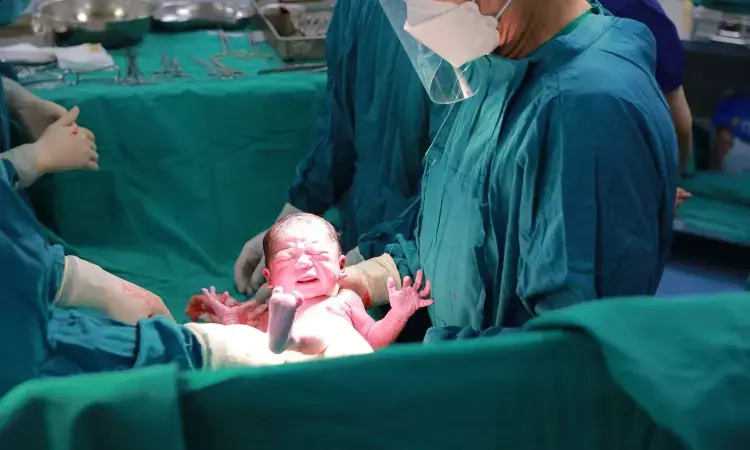- Home
- Medical news & Guidelines
- Anesthesiology
- Cardiology and CTVS
- Critical Care
- Dentistry
- Dermatology
- Diabetes and Endocrinology
- ENT
- Gastroenterology
- Medicine
- Nephrology
- Neurology
- Obstretics-Gynaecology
- Oncology
- Ophthalmology
- Orthopaedics
- Pediatrics-Neonatology
- Psychiatry
- Pulmonology
- Radiology
- Surgery
- Urology
- Laboratory Medicine
- Diet
- Nursing
- Paramedical
- Physiotherapy
- Health news
- Fact Check
- Bone Health Fact Check
- Brain Health Fact Check
- Cancer Related Fact Check
- Child Care Fact Check
- Dental and oral health fact check
- Diabetes and metabolic health fact check
- Diet and Nutrition Fact Check
- Eye and ENT Care Fact Check
- Fitness fact check
- Gut health fact check
- Heart health fact check
- Kidney health fact check
- Medical education fact check
- Men's health fact check
- Respiratory fact check
- Skin and hair care fact check
- Vaccine and Immunization fact check
- Women's health fact check
- AYUSH
- State News
- Andaman and Nicobar Islands
- Andhra Pradesh
- Arunachal Pradesh
- Assam
- Bihar
- Chandigarh
- Chattisgarh
- Dadra and Nagar Haveli
- Daman and Diu
- Delhi
- Goa
- Gujarat
- Haryana
- Himachal Pradesh
- Jammu & Kashmir
- Jharkhand
- Karnataka
- Kerala
- Ladakh
- Lakshadweep
- Madhya Pradesh
- Maharashtra
- Manipur
- Meghalaya
- Mizoram
- Nagaland
- Odisha
- Puducherry
- Punjab
- Rajasthan
- Sikkim
- Tamil Nadu
- Telangana
- Tripura
- Uttar Pradesh
- Uttrakhand
- West Bengal
- Medical Education
- Industry
Budesonide Plus Surfactant Fails to Lower BPD or Death in Preterm Infants: JAMA

Researchers have found in a new study that adding budesonide to surfactant therapy does not reduce the risk of bronchopulmonary dysplasia or death among extremely preterm infants. Bronchopulmonary dysplasia is a leading cause of long-term morbidity in neonates born between 22 and 28 weeks of gestation, and efforts at its reduction have included a number of anti-inflammatory strategies, including corticosteroid therapy. The study was published in JAMA by Namasivayam A. and fellow researchers.
This double-masked randomized clinical trial was conducted across 17 centers in the United States between April 2021 and June 2024. The trial included 641 extremely preterm infants with gestational ages of 22 to 28 weeks or birth weights between 401 and 1000 grams. Infants were eligible for inclusion after a clinician decision was made for administration of surfactant, with the first dose being the study drug. Excluded were any infants who had previously received surfactant.
Infants were randomized in a 1:1 ratio to either a combination of budesonide (0.25 mg/kg) mixed with surfactant (poractant alfa) or surfactant alone. Treatment was given intratracheally via an endotracheal tube within the first 50 hours of life, and 1 or 2 doses were given depending on the clinical condition. The primary outcome was the occurrence of physiologic BPD or death by 36 weeks of postmenstrual age. Five prespecified secondary outcomes and numerous other exploratory and safety endpoints were evaluated, among which were mortality, BPD among survivors, and metabolic adverse events.
Results
Enrollment was stopped early after 641 infants (55.3%) of a planned 1160 due to futility at interim analysis.
The mean birth weight of the enrolled infants was 810 grams (SD, 256 g), and the mean gestational age was 25.9 weeks (SD, 1.9 weeks).
The incidence of BPD or death was almost identical-the respective rates in the budesonide plus surfactant and surfactant alone groups were 68.5% and 67.9% (adjusted relative risk, 1.00; 95% CI, 0.90 to 1.11).
The mortality rates were also comparable-15.3% versus 13.2%, respectively, in the budesonide + surfactant and control group (adjusted RR: 1.13; 95% CI, 0.78–1.64).
Among survivors still in the hospital at 36 weeks, BPD incidence continued to be comparable, at 62.9% versus 63.0%, respectively (adjusted RR: 0.99; 95% CI, 0.87–1.12).
There was a notable difference in metabolic complications: 66.7% of infants receiving budesonide plus surfactant versus 49.8% receiving surfactant alone developed hyperglycemia (adjusted RR, 1.33; 95% CI, 1.17–1.51), suggesting possible systemic corticosteroid effects.
The overall incidence of BPD or death at 36 weeks' postmenstrual age was not decreased in extremely preterm infants when budesonide was combined with surfactant. This multicenter, randomized clinical trial clearly indicates that budesonide-surfactant combination therapy should not be considered as a standard preventive intervention for BPD in extremely preterm neonates.
Reference:
Ambalavanan N, Carlo WA, Nowak KJ, et al. Early Intratracheal Budesonide to Reduce Bronchopulmonary Dysplasia in Extremely Preterm Infants: The Budesonide in Babies (BiB) Randomized Clinical Trial. JAMA. 2025;334(16):1452–1462. doi:10.1001/jama.2025.16450
Dr Riya Dave has completed dentistry from Gujarat University in 2022. She is a dentist and accomplished medical and scientific writer known for her commitment to bridging the gap between clinical expertise and accessible healthcare information. She has been actively involved in writing blogs related to health and wellness.
Dr Kamal Kant Kohli-MBBS, DTCD- a chest specialist with more than 30 years of practice and a flair for writing clinical articles, Dr Kamal Kant Kohli joined Medical Dialogues as a Chief Editor of Medical News. Besides writing articles, as an editor, he proofreads and verifies all the medical content published on Medical Dialogues including those coming from journals, studies,medical conferences,guidelines etc. Email: drkohli@medicaldialogues.in. Contact no. 011-43720751


